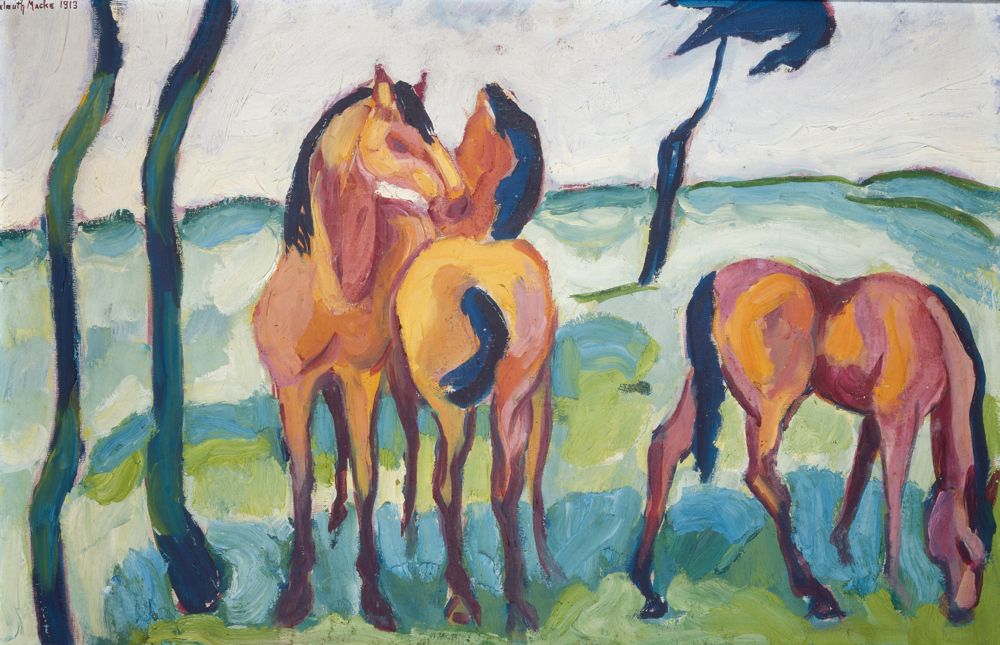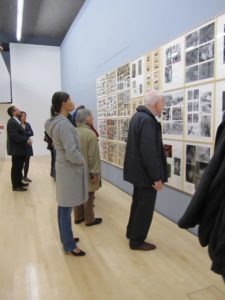
by Jean Marie Carey | 21 Jan 2015 | Animals, Animals in Art, Art History, August Macke, Expressionismus, Franz Marc, German Expressionism / Modernism, Helmuth Macke, Re-Enactments© and MashUps

Helmuth Macke,
Drei Pferde,
1913
“The ‘boarding school’ is in session,” Franz Marc wrote nervously to his friend August Macke.[1] Pining for company in the same letter, Marc nonetheless wondered if August should come and get Helmuth Macke, August’s young cousin, whom the Macke family had deposited some weeks earlier at Marc’s small apartment in rural Sindelsdorf. It was late November 1910. Marc would soon turn 31, and Helmuth was 18. Until Helmuth’s arrival, Marc had been working alone for some time. At the insistence of her concerned parents, Maria Marc had returned to Berlin. Marc was just beginning to see the slightest of incomes from his painting, but he was irritable and distracted. And now August, himself adjusting with his wife Elisabeth to the birth of their son, expected Marc to find ways to entertain a teenager.
Yet Helmuth was resourceful and clever. During the weeks in Sindelsdorf, (which become months and longer: “Helmuth’s fine, he’s still growing,” Marc reported the following summer)[2], Helmuth taught himself enough Dutch to communicate with Heinrich Campendonk; chopped wood and built a fence; practiced painting and drawing, befriended Marc’s dog Russi; and demonstrated a talent for cooking and baking. This latter skill commanded Marc’s particular favor. Animated but sympathetic, Helmuth provided stability and encouragement. By Christmas Marc had breezily informed August that Helmuth would be staying on.[3]
As the calendar turned to 1911, the chrysalis of Sindelsdorf opened and released a new Marc to Munich. Seeking a sophisticated way to celebrate New Year’s, Helmuth pointed Marc toward a performance of Arnold Schönberg quartets. The music had a vivid impact on Marc, which he reported with great excitement to Maria, August, and a new friend who had missed the concert – Wassily Kandinsky. At a the soirée given by Marianne von Werefkin at which Marc and Kandinsky met at last in person, Helmuth was at Marc’s side, and witnessed the twinkle in the eye of fate that became Der Blaue Reiter.[4]
After the party, Helmuth and Franz took the late train from Munich to Penzburg, laughing and marveling over their adventure as they walked jauntily through the falling snow back to Sindelsdorf. Neither traveler was concerned for the future at that joyful moment, and mercifully, neither could know what the future held.
Helmuth Macke died in 1936 when his small boat capsized in a sudden storm on Lake Constance, having given his sailing companion the only life preserver.
[1] Franz Marc, August Macke: Briefwechsel. (Köln: DuMont, 1964), 20-21.
[2] Marc and Macke: Briefwechsel, 42.
[3] Marc and Macke: Briefwechsel, 28.
[4] Dominik Bartmann, Helmuth Macke, (Recklinghausen: Verlag Aurel Bongers, 1980), 26.

by Jean Marie Carey | 28 Jul 2014 | Animals, Animals in Art, Art History, Franz Marc, German Expressionism / Modernism, LÖL

Brigita Hofer cleans, fills, patches, and recolors “Paradies.”
Here is a short article on the ruhr.de website about the restoration of the Paradies mural made by Franz Marc and August Macke in 1912 at the Mackes’ home in Bonn. It’s an interesting little piece and the website also has some photographs of the movement of the mural, in the 1980s, from its original location to the Museum für Kunst ind Kultur/Westfälisches Landesmuseum in Münster, where it lives today (there is a pretty nice replica at the August Macke Haus though). Like a lot of people I am sad that the museums can’t just switch the murals back, but this article sort of explains why that will not happen.
The restorer, Brigita Hofer, has discovered that the mural is pretty structurally unsound, giving it a soundness rating (as happens with earthquake-damaged buildings as I recently learned) of around 25, which means there’s a better than one in four chance it could collapse under any further stress. Hofer has been filling in surface cracks and erosions with non-expanding plaster and emulsifier with the tiniest of syringes. Hofer also restored some of the mural’s damaged or faded paint. In doing so she discovered that Macke and Marc had made a lot of adjustments to the mural as they worked together, repainting Eve’s face and the deer. Hofer also learned from a heretofore covered note that Maria Marc had painted the wasp at the bottom of the mural.
I am fascinated with this mural, as you might guess from how often I write about it, not for the least reason that it seems to be a truly collaborative effort that resulted in a distinct “style” that is identifiably that of both painters but is also a unique meshing of their ideas and talents. Even the animals don’t look exactly like Marc’s other animals, and for both, the palette is a bit subdued. (Except Adam reaching to embrace the monkey on the top left branch though and turning from the other figures – I think that’s a Marc thing. There is a large image of the mural in the post just before this one.)

by Jean Marie Carey | 2 Dec 2013 | Art History

Lorna Simpson @ Haus der Kunst
One of the aspects of Lorna Simpson’s work I have always admired is the technical quality of her photographs. At her recent press conference at Haus der Kunst she confirmed what you’d expect from examining the gelatin prints in particular but really, upon close in-person inspection, her oeuvre: that Simpson develops, prints, mounts and even frames most of her photos by herself in a darkroom/studio in New York City.
This sort of mid-career retrospective represents more than 30 years of of photography, film, video, and drawing. Known (as in these photos have entered the canon) for her mid-1980s for her language driven large-scale works combining photographs and text, Simpson’s effective enigmas are clearly coded but spacious enough to still wonder about. One of the most interesting works on view in München are a series from the 1990s of large multi-panel photographs printed on felt, accompanied by text panels describing their locations and the intimate encounters that are described but only hinted at visually. At the edge of the Englischer Garten where something exactly as described is probably happening right now only not as well concealed, the effect was actually humane and tender as opposed to amusing. The exhibit, which unfortunately overlaps with some other very strong show and with Haus der Kunst’s interactive festival also showcases Simpson’s film and video works, a group of watercolors, and an archive of found photographs from the 1950s, which Simpson has embellished by creating replicas of, posing herself to mimic the originals.

by Jean Marie Carey | 10 Nov 2013 | Art History, Franz Marc, German Expressionism / Modernism

Atlas Mikromega @ the Lenbachhaus
A few years ago I went through a phase of being consumed with interest in Gerhard Richter’s cycle of 15 paintings, Baader-Meinhof (18. Oktober 1977). Writing this now my obsession seems doubly strange because I did not then have the geographic or cultural context for these works I have in 2013. One spring break I had seen the paintings – based upon photographs of Ulrike Meinhof, Holger Meins, Gudrun Ensslin, Andreas Baader; the funeral of Jan-Carl Raspe, and Baader’s books and record player – at the Museum of Modern Art and had a very strong reaction to them. I think I explored this subject so intently because my response was the opposite from my feelings for Franz Marc’s animals. The blurred details of the black and white photographs of portraits, news stills, and police snapshots made the subjects abjectly lifeless. The effect was like the dream of freezing; cold, sad, and bitterly empty. The paintings made me drained and ill. Yet I was fascinated by the tension – and desire – that was generated by being repelled by images whose subjects I was very drawn to.
(more…)

by Jean Marie Carey | 5 Nov 2013 | Animals, Animals in Art, Art History, Franz Marc, German Expressionism / Modernism, LÖL
Recovered Blue Horses

So you have probably heard by now the incredible story of how hundreds of amazing paintings were recovered right here in München – right here in Schwabing! – from the derelict apartment of an “art dealer” who had stored them in haphazard fashion amid cans of apricots and bottles of sherry. Included in the cache are long-missing works by Max Beckmann, Picasso, Renoir, Matisse. Of course most happily found is the painting above, one of Franz Marc’s Blue Horses missing for more than 70 years.
It has been super-exciting to be so lucky to be here for this momentous occasion. Everyone – not just at the museum but everyone in the city – is talking about the fantastic aspects of the story (please read up on it; it’s sure to become even more fascinating) but what is most awesome is the jubilation and delight people are expressing. I can’t think of many places where a city-wide celebration would erupt over such a story.
Of course I am not unmoved. FOCUS magazine broke this story on Monday. When I saw the headline in the Süddeutsche Zeitung’s Twitter feed I ran out to the news vendor to get a copy and snagged the last one, and the last print SZ in the stack too. I am very happy to have these print artifacts of this wonderful occasion.
Here are links from the Daily Mail (UK); Time Magazine (US); and Süddeutsche Zeitung (DE).
I am thrilled that one of the missing Blue Horses was found period, but it’s beyond overwhelming to be right here…Hopefully Turm der Blauen Pferde is hanging out in someone’s garage or wine cellar or something.




